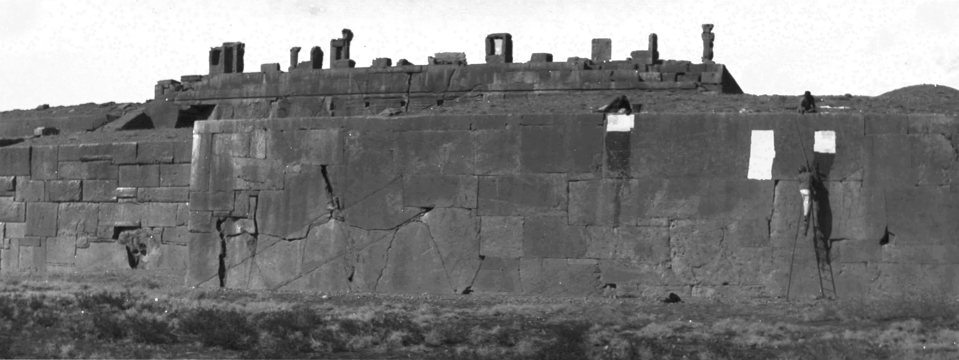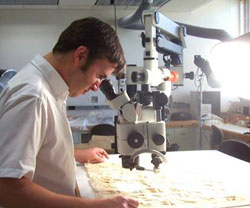Squeeze Making
 Persepolis panorama. Making squeeze of foundation inscription. Negative no. 4072. Ernst Herzfeld papers, Freer Gallery of Art and Arthur M. Sackler Gallery Archives.
Persepolis panorama. Making squeeze of foundation inscription. Negative no. 4072. Ernst Herzfeld papers, Freer Gallery of Art and Arthur M. Sackler Gallery Archives.
Definition of a Squeeze
A squeeze (in French, cliché; in German, Abklatsch) is formed by pressing soft, wet, moldable paper, pulp, latex, or plaster into a low relief inscription. When the material is dry and removed, it becomes a multidimensional mirror-image representation of the original inscription. The Freer|Sackler Archives holds 393 squeezes from the ancient Near East, the largest collection outside of Iran and Iraq.
History of Squeeze-Making
The method of making squeezes from ancient inscriptions was employed as early as the eighteenth century. Most of the European adventurers, archaeologists, and scholars who organized expeditions to the Middle East-most notably, Lottin de Laval and Waldemar Belck-were trained in these techniques. The squeezes they brought home from these trips throughout the nineteenth century were vital tools for deciphering ancient languages. Many late nineteenth- and twentieth-century publications included both drawings and photographs of squeezes, revealing the characters contained in the inscriptions. Squeeze-making also was used as an early alternative to photography, as the materials were cheaper and easily portable, and the end product still allowed one to see the state of the original text.
Ernst Herzfeld's Squeezes
In his papers, Ernst Herzfeld frequently describes the squeeze-making process. The F|S Archives contains a few of his notes from 1923 and 1933. 1 In his 1933 diary he states, "I did them all with cigarette paper, folded three times. The result is good."2 Hans von Busse assisted Herzfeld in 1933, and in a letter to his father he writes:
"We had made casts. […] One takes enough large sheets of extremely thin cigarette paper that is carefully hammered on with a hard brush, while damp. When it is well molded to the form, new layers are progressively overlaid. […] Once it is dry one can lift off the paper layers, which are now firmly stuck together, and one has an exact reproduction of the original."3
An initial conservation review of the 393 squeezes in the Freer|Sackler Archives showed that they are composed of materials of varying quality. While some are made of thin cigarette paper, as Herzfeld and Von Busse described, other squeezes are made of crisp, white, robust paper, and in rare cases, pure tin.
Researching Squeezes
Careful examination of these squeezes can sometimes lead to corrections, new dating, and other surprising results. By analyzing the raw incidental artifacts that were picked up as molds were being made, Dr. Alex Nagel, F|S assistant curator of ancient Near Eastern art, was able to identify the paint pigments left in the squeezes. To learn more about Dr. Nagel's work, please contact him at NagelA@si.edu.

Dr. Alex Nagel examining pigments left on a squeeze from the inscriptions of the façade of Darius I (d. 486 BCE)]
Squeezes have come to play an increasingly important role in scholarship. They make it possible to learn about ancient cultures even when original inscriptions have deteriorated to the point of illegibility, archaeological sites are inaccessible, or research funds do not support onsite visitation. Plaster casts and squeezes of ancient monuments created for museum collections have facilitated proper translation of past languages, which in turn has provided a window into past cultures. In addition to accurate language identification and translation, squeezes also can be used to physically and conceptually reconstruct ancient monuments.
Note on Inscriptions
Political figures in the ancient Near East tended to take credit for public works they performed by commissioning monumental inscriptions. Temples, buildings, and statues sponsored by a ruler are likely to have an inscription bearing his name and that recorded such accomplishments as battles won, titles acquired, or gods appeased. Inscriptions have proven very useful in tracking the reign of a ruler.
The squeezes in the Freer|Sackler Archives come from thirteen identified archaeological sites: Bastam, Isfahan, Rayy, Samarra, Shiraz, Sunghur, Taq-i Bustan, Tus, Sarpul, Pasargadae, Persepolis, Naqsh-i Rustam, and Paikuli. They contain cuneiform, Middle Persian, and Arabic scripts. The cuneiform squeezes represent at least six archaeological sites. Cuneiform script was the dominant form of writing in the Middle East for millennia and was used until as late as the second century CE. Read left to right, the script is wedge-shaped and takes different forms when writing in Elamite, Akkadian (Babylonian), or Old Persian. The Middle Persian squeezes are the largest group represented and span across seven archaeological sites. Middle Persian scriptures, also referred to as Pahlavi, were used in official texts by the Sasanians between the third and seventh century CE. Squeezes in the collection that contain Arabic script comprise mostly architectural design or motifs and come from at least six archaeological sites.
Some collections today contain fake inscriptions, created for their aesthetic appeal. As modern interest in ancient Near East texts increased, researchers recognized the need to develop conventions for proper identification. To this end, the Corpus Inscriptionum Iranicorum aims to publish a comprehensive and permanent record of Iranian inscriptions and documents. The first volume was published in 1957.
For further reading on inscriptions, please see the Herzfeld and Squeeze Resource Bibliography.
1See also Ernst Herzfeld papers 1926 Diary: 246-247.
2Ernst Herzfeld papers, N-84 (1923–24), November 22, 1923: p. 18.
3Ernst Herzfeld papers, correspondence, September 23, 1933: p. 4.
Using the Collections
- Archives Home
- Archives Collection Highlights
- Archives Collection Descriptions
- Doing Archives Research
